World Cup Preview: Belgium
Belgium with their so-called “golden generation” could be a real challenger for this World Cup, since their overall quality puts them among the best national teams. Although their individual quality doesn’t mean anything, if the players are not being put into a functioning structure. Marc Wilmots’ tenure showed us the negative side of that, therefore it was necessary to hire a coach who is able to solve this problem both from a strategic and from a tactical perspective. After his first 3 games Roberto Martinez found a solution, implying a 3-2-4-1 system, which looks to be the most optimal choice the Belgians could use.
This 3-2-4-1 system has several advantages, especially if we look at the available squad: in this system neither Verthongen or Vermaelen is forced to play as a full-back, which was a big issue earlier, when they were using a 4-defender system – mostly it was Verthongen, who had to play as a left-back. Also, this systems allows the wingers -Mertens and Hazard- to be positioned in a very flexible way, mostly occupying the halfspaces in between the lines, but they have the freedom to move outwards towards the flanks, in order to create advantageous situations against the oppositional full-backs. The central-midfielders are operating in a less flexible way, which is possibly a big disadvantage, since De Bruyne is mostly being forced to play in a deeper role in front of the oppositional second line, where his real strengths – e.g. running in behind the oppositional last line from depth- could not be exploited. Next to him it’s usually Witsel, who has a more defensive role, therefore even if De Bruyne decides to move higher one central-midfielder still occupies the space in front of the centre-backs. As wing-backs we could most often see Meunier at the right hand side, and Carrasco as a left-back. Whilst Meunier excel in running behind the opponent – which is in most case the oppositional winger –and receive the ball a lot in space, Carrasco’s strength is much more to receive the ball at his feet, from where he can dribble towards the goal diagonally.
In Possession – Role of the centre-backs
Since implying a 3-defender system there is a bigger emphasis on the sideback’s quality to control the circulation, where both Alderweireld and Verthongen may excel. Their ability to drive forward with the ball and manipulate the oppositional second line is exceptional, which is essential to have a proactive possession play. Therefore they tend to move higher in the halfspaces at the circulation phase in order to have a better connection with the attackers and to create a connection with the ball-far side. Against 4-defender systems they usually have a lot of space to drive forward to, since most teams are using man-marking to close down the high wing-backs and narrow wingers. This basically generates a big space in between the oppositional wingers and central-midfielders –mostly in the halfspaces-, therefore the sidebacks have even more space and time for any actions on the ball. One possible solution might be from the defensive sides –in a 4-defender system-, to allow the sidebacks to drive forward as a defensive trap, and force them towards the sidelines with a curved run from the inside. The issue with this is that since closing down the sidebacks from sidewards still leaves the vertical and diagonal passing lanes open, which could be exploited, because of the wingers’ man-marking stretches the whole second-line, therefore these passing lanes are generally open, especially towards the attackers.
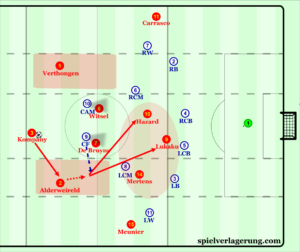
Situation when the sideback is being closed down by the oppositional first line – with the possible vertical and diagonal options for the sideback.
Besides, the sidebacks aggressive on the ball actions usually create an issue for the oppositional side to close them down, especially between the first line and the wingers. From the decisional-crisis that it creates, the Belgians could progress through the wider zones in some cases. If the oppositional first line closes them down, they usually do it sideways, which in fact may force the sidebacks into a wider position, although still leaves valuable passing lanes open –as described before. If the wingers close them down, then it forces the wingers to occupy a higher position –to have greater access to the sidebacks-, which may open up more space in behind, and may also open up a direct passing lane towards the wingers/wing-backs at the flanks. From these situations, they could immediately create 1v1 situations for both Carrasco and Hazard on the left side. With pulling out the wingers in defending they could also create bigger distances from the oppositional full-backs, which provided enough time to receive, turn and look for options on the ball for Meunier and Carrasco, meaning they couldn’t be isolated next to the sidelines and could also dribble inside and look for runs in behind or to pass back to the centre-backs to facilitate the further circulation.
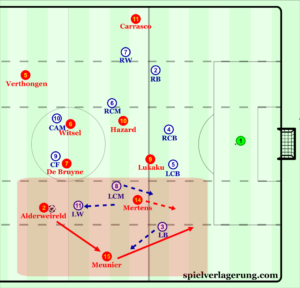
Situation when the sideback is being closed down by the oppositional winger – progressing through the width dynamics, exploiting the late press on the wing-backs, attacking the space behind the full-back, creating separation from the oppositional central-midfielder.
Against 1-man first line – 4-1-4-1/4-4-1-1/5-4-1 – the sidebacks usually had even more space and time for on the ball actions, therefore they could not only create better connections with the players on the ball-near side with decreasing the distance between each other –especially the connection with the wingers-, but they had more opportunity to pull the oppositional defensive shape towards the ball-near side more, opening up space on the ball-far side for the wing-backs for a diagonal long ball. In these situations either the central-midfielders have more space to operate in front of the oppositional second line. From here they could manipulate the oppositional central-midfielders –pulling them out-, in order to open up passing lanes towards the wingers.
From driving forward the target-men are the 3 attackers: basically both Hazard and Mertens is actively looking for open passing lanes in between the lines, attacking the space between the oppositional winger and central-midfielder. If they are not open or accessible then Lukaku’s role and movement gets into light: his physical ability allows him to receive even the toughest vertical balls and to lay these ball off towards the Hazard & Mertens, who are immediately moving towards him to provide him adequate options. Their flexible movements also allows to create ball-oriented overloads, with Hazard moving from the left to the right, to create a better connection and numerical superiority with Mertens.
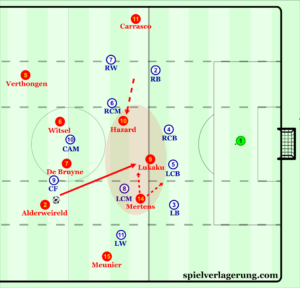
Offensive pattern: vertical/diagonal ball onto Lukaku’s feet – both wingers are immediately making supportive movements towards him to offer lay-off options.
Wingers’ movement -Hazard & Mertens
A key feature in their movements is the deep positioning: they usually position themselves closer to the oppositional second-line, which have several advantages. At first, this creates a smaller distance from the sidebacks and the central-midfielders, creating better connections for any possible passing situation. Also, with moving closer to the second-line on one hand they can create a separation from the oppositional full-back –who in most cases tend to follow them with tight marking-, meaning they could operate in between the lines without being heavily marked from the back –reducing the oppositional cover. In this way it’s usually the central-midfielders are the ones, who close down the wingers, which have some strategical advantages: with being positioned behind them –or even against tight marking- it’s easier to create separation from them with their often used runs in behind the oppositional last line –behind the oppositional full-back who steps out to close down Meunier & Carrasco. Besides, even with being marked tightly this creates on the ball actions for Hazard & Mertens, where their ability to dribble and ball-retention can be exploited to get behind the oppositional second line, even without facing the oppositional goal.
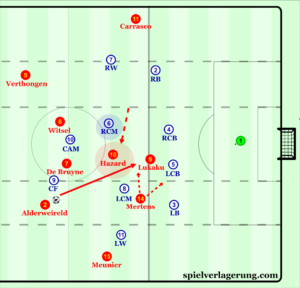
Hazard’s movement towards the right side, to create an overload and a possible numerical superiority, leaving the oppositional central-midfielder in a decisional-crisis, to follow him or not.
Another possible movement from the wingers is to switch positions with the wing-backs. In this way they can create advantageous situations – possible 1v1s- for the wingers, facing the oppositional goal. This is where especially Carrasco’s flexibility becomes essential, as he could also operate effectively even with moving into the halfspaces, since he is originally a winger. Therefore this movement happens much more on the left side, where Hazard moves outwards & Carrasco takes his position, creating more dynamic combinations possible. In these situations they could stretch the oppositional last line, opening up more space behind the full-back who steps out to close down Hazard at the flank, creating gaps that could be exploited with runs from deeper positions behind the last line.
From this 3-2-4-1 staggering even against heavily man-oriented defensive system several possible solutions could emerge. A typical combination to use is a depth switch between the wing-back and the winger. In that case the wing-backs could easily exploit the oppositional wingers’ defending with runs in behind –this has been used very effectively from Meunier at the right side. With stretching the oppositional second-line it creates more space for the wingers to cut & dribble inside after receiving the ball –exploiting the bigger distances and disconnections.
Build-up
At goal kick situations the sidebacks and wing-backs did occupy appropriate positions to create adequate connections, therefore they could progress through the oppositional press in most cases. Hazard’s and Mertens’ role was also essential even at this phase, as their deep positioning usually forced 1 oppositional central-midfielder to stay deeper and cover them, which created a free-man at the back, usually De Bruyne.
It was especially visible against Costa-Rica, where at first the away side could effectively press Belgium’s build-up with basically man-oriented 3-4-3 press, although through De Bruyne’s and the wingers’ intelligent positioning they could open up valuable spaces. With both central-midfielders, De Bruyne and Witsel dropping deep they could pull out the oppositional second-line centrally, which opened up huge spaces for Lukaku to receive & Hazard-Mertens to move for the second-ball and lay-offs in between the lines. Not only the central-midfielders, but the wingers started to move deeper, therefore they caused a decisional-crisis for the oppositional centre-backs, to follow or to stay in position. In react to that an oppositional central-midfielder dropped deeper to give cover for the centre-backs against Hazard and Mertens, which meant a free-man at the back – usually De Bruyne.
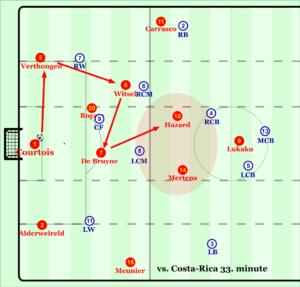
Build-up structure under pressure: with the wingers’ deep positioning they are able create a decisional-crisis for the defensive side, especially for the central-midfielders and the centre-backs. If the central-midfielders decide to move higher up, they may offer an accessible forward option even for the sidebacks. Even if they are being forced to play long ball, they are immediately able to exploit the spaces in between the lines that this structure creates.
Their build-up issues although mostly come from the open play situations: when passing it backwards to Courtois, the sidebacks occupy a very wide position, therefore they are not providing adequate options and connections at the back. Even if Courtois may find them at first, they are usually forced to a long ball because of the inadequate positioning. This might be a result of the wing-backs higher positioning, as in this way the sidebacks’ move out even wider to stretch the oppositional press. In these cases De Bruyne’s functional dropbacks offered a possible way out for Courtois, although if he is being pressured well, the Belgians have serious issues to effectively build-up after backwards passes to Courtois in open play situations.
Attacking third
The whole idea in the offensive third is to create crossing situations out of the wide dynamics: this means a lot of deep runs behind the oppositional last line both on the ball-near and the ball-far zones. After creating the crossing situations the goal is to look for Lukaku, who usually attacks the space behind the ball-far centre-back, trying to operate from his blind-side in order to create separation -get behind or move towards the ball.
Here is where De Bruyne’s and Witsel’s/Dembele’s role might be exploited more effectively. The oppositional man-orientation with stretching the second line creates more space & time – Pam pam, hello Xavi- on the ball for the central-midfielders, for diagonal dribbling –opening up passing lanes towards the attackers in between the lines- or for long shot situations. In these zones the central-midfielders usually had more touches on the ball, whilst at the circulation phase their role is less active, because of the basic structure and organization principles.
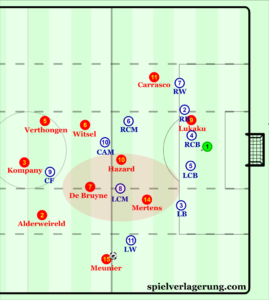
At the attacking third usually more space opened up for De Bruyne for on the ball actions, complemented with Hazard’s overloading movement it created a much better dynamics at the ball-near side.
With Hazard-Mertens playing in a deeper role a bigger issue may occur: since having a bigger emphasis on their link-up play in the early phases, they are being used less in the finishing phase, in terms of finishing the attacks. From the wide dynamics with Meunier and Carrasco sometimes it’s the wing-backs who are able to get behind the oppositional shape, therefore they are the ones who must offer the key passes to Lukaku, or the ball-far wing-back, who does also arrive into the box the attack the far-post zone. On one hand that is why Hazard moves out wide more, to have a bigger role in providing these passes into the box. When Hazard moves over to Mertens’ side the basic dynamics changes: since creating an overload it’s possible to either create a superiority against the oppositional second line or to pull out a centre-back, where the space behind could be exploited with Lukaku-Meunier run in behind. Therefore their role is a bit different in the finishing phase, mainly focusing on creating quality situations for the full-backs and Lukaku in front of the oppositional box.
Issues
As I wrote earlier to system doesn’t utilise De Bruyne’s ability to receive or get behind the opponent in between the lines, therefore their circulation often becomes stable and easily neutralized, if the passing lanes towards the wingers is being closed down appropriately. One solution could be to push De Bruyne higher in possession in between the lines, and create a 3-1-5-1/3-1-3-3-ish staggering, which would lead one more player in between the lines.
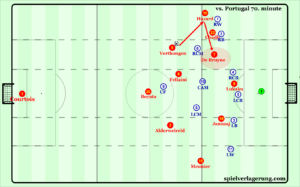
With De Bruyne moving higher up in between the lines, he could act as a free-man, offering an extra option for the diagonal balls.
With the heavy emphasis on building through the halfspaces the ball gets out to the wing-backs a lot, where they lack the dynamism at the right side. Meunier often left alone, without having a proper supporting structure around, therefore he might be isolated on ball. Especially against properly timed press from the full-backs, where he couldn’t create separation with his first touches, and was often forced to play it long toward Lukaku – that’s what Mexico tried to do, with constantly forcing Belgium to build through Meunier, then trapping him there. This issue also happened after diagonal switches to the far-side from the centre-backs, where both wing-backs were often left without options. Using Carrasco or Chadli as left-backs could offer as a solution against being isolated, since on one hand they could create a small separation from the opponents’ with their first touches towards the centre – as they are both right footed, first touch oriented towards the centre-, and on the other hand their ability to dribble diagonally inside could also create a separation and force the oppositional second-line to drop deeper, meaning the backward route towards the centre-backs opening up, leading to a stable possession phase.
Even though creating penetrating situation relatively lot, their options after progressing through the oppositional second line are not quality enough. With the wing-backs being a bit deeper then the oppositional last line, they can’t offer immediate width option for the ball carriers –usually for Hazard and Mertens-, therefore the players in between the lines can only operate between themselves. If the wing-backs would be positioned higher they could offer a better option, with keeping the dynamical superiority after progressing through the oppositional second line. Also as I wrote before, their positioning usually creates man-marking on the wing-backs & wingers, which in fact tightens the oppositional last line, therefore after the progression the oppositional shape is not being stretched enough horizontally, leaving less quality options for the ball-carrier.
A recurrent issue is their circulation at the back, as for most cases the basic goal is to create space for the sidebacks to drive forward, the central-defender therefore often very passive, with using only horizontal passes to either sidebacks. As the basic staggering doesn’t tighten the oppositional first line well, plus they are already being positioned to have access towards the sidebacks, it opens up spaces centrally, although this is not being exploited at all. With having space centrally the central-defender could easily drive forward and manipulate either the first – or second line and open up valuable passing lanes from the central zones. With a more aggressive possession display from the central-defender the sterile circulation could be prevented, whilst other valuable options may emerge -though this has been used in some cases by Kompany, but with a more conscious and frequent usage, this could be an extra option at the circulation phase.
Apart from the central-defender’s inactivity, their circulation often becomes schematic without being able to successfully move the oppositional defensive shape. A usual problem is basically the lack of circulation, especially when the sidebacks receive the ball, as they often drive forward on the ball, even when they shouldn’t. In that way they are being forced towards the sidelines often without quality passing options, therefore they must kick it long towards Lukaku. Thus, they are being forced into the wider zones too early, not being able to circulate the ball in a more constant and controlled way. In that regard the sidebacks’ orientation and first touch issues are definitely an area they should improve in, with an increasing orientation towards the constant circulation, and better selection on when to actively drive forward into space, to whilst being focused on maintaining quality connections and avoid being isolated.
When Hazard occupies his original zone, issues occur with effectively creating spaces in between the lines, that’s why his intelligent movement and positioning is so essential for proactive progressions. In these situations the central-defender’s active role could be one solution, as outlined above. Also when there is no access towards Hazard-Mertens or even Lukaku, the wing-backs movement can offer a way out to get behind the oppositional shape. Their playing style basically offers different possibilities: Carrasco rarely positions himself to drop deeper, whilst Meunier does it more often, to basically offer an exit route for Alderweireld, if he is not able to find vertical or diagonal options after driving forward on the ball. In that way Carrasco’s role is much more to receive the ball at higher positions, using his dribbling ability to cut inside diagonally and look for possible combinations with Hazard – who in these cases runs behind the oppositional last line more. On the other side Meunier receives the ball more in space, with aggressive vertical runs behind the oppositional winger, even after combination plays with Mertens –so not only direct through balls from Alderweireld or De Bruyne.
Out of Possession
In defending they use a 5-4-1 formation, which becomes much rather a 5-2-3 through the staggering. The 3 attackers usually stay a bit harder at the middle-and offensive third, gradually dropping deeper when defending at the own half, only leaving Lukaku higher. The central-midfielders also have different roles, whilst De Bruyne often moves higher especially when pressing backpasses, Witsel stays deeper in front of the centre-backs to offer defensive depth support in front of them. From there he might also drop deeper into the last line, in case that is being stretched, especially in shifting situations.
High Press
Their basic pressing movements tend to be a bit man-oriented, therefore they could be stretched vertically, with pulling Witsel-De Bruyne into higher zones, if the oppositional central-midfielders decide to drop into a deeper position. Although their horizontal compactness compensates this, therefore Witsel is not being forced to step out, with the ball-far wingers’ moving inside to close down the central zones. With having a proper local compactness they are able to press the ball with an adequate timing, especially at high pressing situations, preventing the possible switches or diagonal balls towards the ball-far zone, where their horizontal compactness might be exploited.
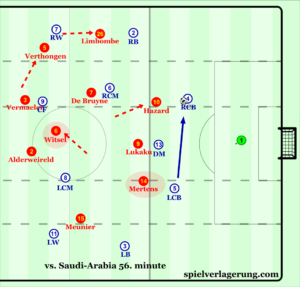
Pressing scheme: since their first-line presses in a very narrow way -with Lukaku dropping onto the oppositional DM-, it does not only creates great access and local compactness around the ball, but it also allows Witsel to act as a free-man in front of the centre-backs.
Last line shifting movements
A key cornerstone of a 3-defender system is the way their last line shifts in the horizontal axis. Basically there are 2 types:
- The wing-backs push higher up to close down the oppositional full-backs, even with the oppositional winger staying out wide – in this case the wing-back is pushing up, whilst using his cover shadow to close down the direct access towards the oppositional winger -› also giving time for the sideback on the ball-near zone to have time and close down the oppositional winger with moving outwards.
- if the oppositional winger is occupying a more central position, then the wing-back may push higher up in a more aggressive way, closing down the opponent using his cover shadow to cover the passing lane towards the centre
- The wing-backs are staying in position, therefore it’s the wingers who have to move outwards and close down the oppositional full-backs
- the latter usually happens when both the full-back and winger is staying out wide
In this regard the Belgians have serious issues, since the tend to vary these two shifting methods, regardless the opponent’s behavior. Therefore we may see wing-backs pushing higher up against double-width oppositional systems, and we may also see wing-backs staying in position & stepping out way too late, even against one-width oppositional systems. This uncertainty slows down the whole shifting process, leading to late presses on the ball and spaces opening up behind the defensive structure. Thus not only their defending at the wider zones have issues, but also the last line’s shifting in the central zones, since the wing-backs tend to occupy a wider position in order to be able to press in time at the wider zones, although this leave huge gaps between the wing-backs’ and sidebacks’ that might be exploited.
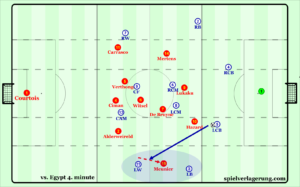
With Meunier stepping up too early in order to close down the oppositional full-back with an appropriate timing, it opens up the direct passing lane towards the winger, exploiting the inadequate shifting of the last line.
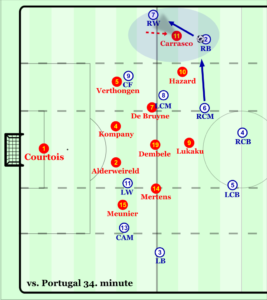
Even with Carrasco trying to close down the winger with his cover shadow, it still opens up the access towards him. With trying to use his cover shadow he firstly turns towards the outside, which in fact opens up just enough space and time on the ball for the full-back, so that he is able to exploit it.
First line defending
Besides their last line’s shifting issues, Lukaku’s defensive role might also be a huge weakness in the defensive phases, since he mostly takes part at high pressing situations. When the whole structure is defending in the middle-or defensive third, he tends to stay higher, leaving a huge space in between the first and second line, where the oppositional side may operate in a basically free manner. Because of this, the second line becomes easily manipulative, it’s possible to pull out De Bruyne-Witsel centrally in order to open up passing lanes towards the attackers, who therefore have a bigger space in between the lines. Although -as stated earlier-, their second line defending is very narrow, and there movements to cover passing lanes functions really well, despite the central-midfielders are forced to step out in most cases. As an advantage of the 3-defender system, even if the second line is not covering the passing lanes well, the centre-backs are allowed to aggressively step out of the last line to close down opponents down.
Since leaving Lukaku higher up, they also have issues, with forcing the oppositional possession backwards. With leaving a huge space in between the first and second line, they are not able to force the oppositional side to backpasses, moreover with the late presses on the ball the opponents’ may have longer passing sequences, forcing the Belgian side into a very deep defending at their own half. Occasionally Lukaku drops deeper to leave the oppositional centre-backs open & force out backpasses, although these triggers are also not being used in functional and collective way. Although in these cases their whole defensive structure becomes more stable, since they are able to slow down the oppositional circulation and force them towards the sidelines, where with appropriate last line shifting the oppositional side might be trapped or closed down.
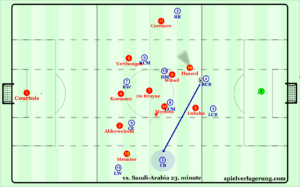
Attacking backward passes – even with using the backpass as a trigger to push the whole defensive structure higher up, they have several issues with closing down the opponents from an adequate angle and time, therefore even with the first and second line pushing up, options remain open for the oppositional team.
3-1-4-2 – A possible change
Apart from the basic system, the Belgians occasionally implied a 3-1-4-2, with more or less success. After their worst friendly game against Mexico, where the basic strategy has even been criticized by De Bruyne, Martinez might consider it twice to use this system, although it may offer some advantages in case of the basic system is not functioning well. From a single strategic point of view the 3-1-4-2 offer better occupation in the spaces in between the lines, since there are 4 players to occupy that, which offers better vertical & diagonal options and combinational possibilities. In that system De Bruyne is actually allowed to move higher, in order to receive the ball in higher zones. Although in that game the main issue was their defending, since Mexico’s staggering created 7v5 situation against Belgium’s second and first line, from where their build-up and possession game become quite free-flowing. We might not see this from the Belgians, though it still remains as a possible ‘Plan B’ for Martinez, to add some variability to the actual gameplan.
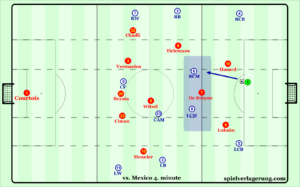
Mexico was able to create a 7v5 situation, through their staggering – with using wide wingers they were able to keep the Belgian wing-backs in position/decisional-crisis, opening up the access towards either the full-backs or the central-midfielders.
Transitions
A huge advantage of the 5-2-3 staggering is the potential variations that it offers at offensive transition moments. With the wingers occupying a higher position in the defensive phases, they are immediately able to run behind the oppositional last line, or they could just move outwards, where they are able to receive the ball at their feet in order to immediately create possible dribbling situations against either the centre-backs or central-midfielders. This is where both Hazard and Mertens may excel: whilst Hazard usually move outwards or drops deeper a lot, to create dribbling opportunities against the oppositional central-midfielders, Mertens much rather uses his speed to make runs behind the oppositional centre-backs, or just as Hazard to move outwards and receive at his feet. If neither of them is accessible, then Lukaku’s importance arises again, using strong vertical balls into his feet, and possible lay-offs towards the wingers. Not only the wingers’, but also De Bruyne’s ability to play accurate through balls -his runs from deep positions also- into space makes the Belgian offensive transitions exceptionally dangerous. In case neither option is accessible, then the wing-backs could be a potential target-men, since they are immediately able to exploit the spaces behind the oppositional full-backs, therefore they can provide the width for the Belgian counter-attacks.
In defensive transition moments the usual vulnerable space in a 3-defender system -between the sideback – wing-back- is definitely an area, where the oppositional sides are going to have a chance to go behind the Belgian last line. Even with using a heavily ball-oriented counterpressing system, these space do usually open up, if the oppositional side is able to get through the first line of counterpress. When losing the ball the wing-backs are immediately moving towards the centre, to tighten the defensive shape and to create a better access towards the ball, which creates a huge central occupation after losing the ball. Although this is definitely a phase where Witsel’s and De Bruyne’s central positioning gets a bigger emphasis, so even if losing the ball at the circulation phase, the central-midfielders are immediately able to close down the spaces in front of the centre-backs.
Conclusion
Under Roberto Martinez the Belgian team went through a big development, in terms of of their tactical and strategical details, which is expectedly going to have a positive effect on their future performances. Although it’s tough to predict how are they going to perform in this World Cup, we can be sure that this is not going to be the same unstructured and tactically unprepared team that we have seen under Marc Wilmots in the last European- and World Championship.
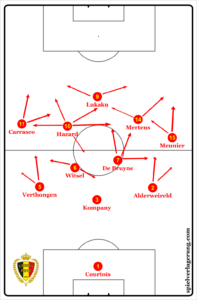
Keine Kommentare vorhanden Alle anzeigen